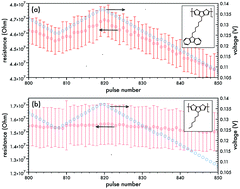Exploiting multiple percolation in two-terminal memristor to achieve a multitude of resistive states†
Abstract
As the most likely prospect for the construction of neuromorphic networks, the emulation of synaptic responses with memristors has attracted attention in both the microelectronic industries and the academic environment. To that end, a newly synthesized hybrid conjugated polymer with pendant carbazole rings, that is, poly(4-(6-(9H-carbazol-9-yl)hexyl)-4H-dithieno[3,2-b:2′,3′-d]pyrrole) (pC6DTP), was employed in the fabrication of a two-terminal memristor with a Al/pC6DTP/ITO configuration where the polymer was electrochemically doped. Signature biological synaptic responses to voltage spikes were demonstrated, such as potentiation & depression and spike timing dependent plasticity. The device was able to be programed through a 1 mV pulse, requiring only 100 fJ of energy. The voltage-dependent conductive nature of the polymer was speculated to occur through two synergistic mechanisms, one associated with the conjugation along the backbone of the conjugated polymer and one mechanism associated with the pendant heterocyclic rings.



 Please wait while we load your content...
Please wait while we load your content...